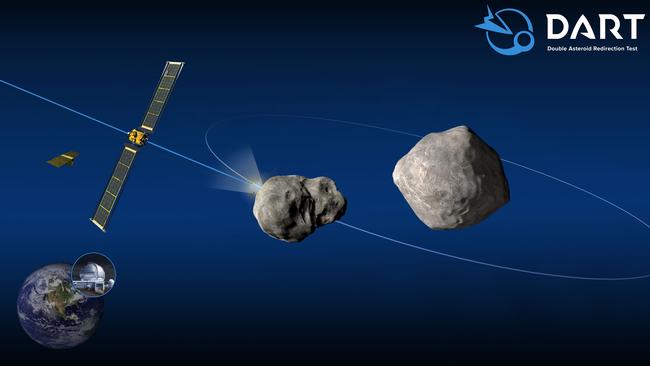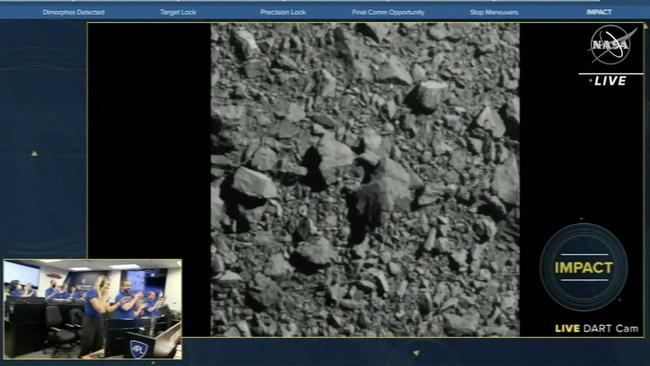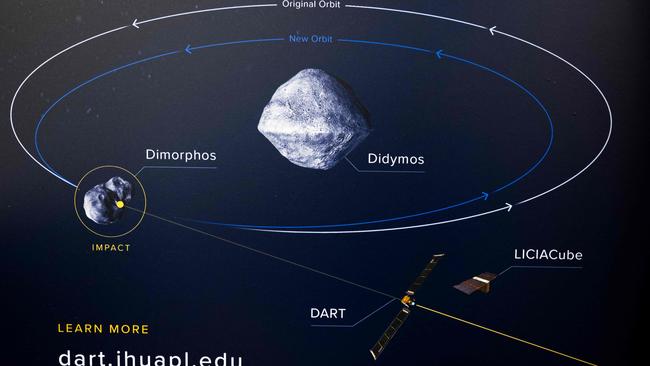Double Asteroid Redirection Test (DART): NASA crashes spacecraft into asteroid
NASA is celebrating after slamming a fridge-sized spacecraft into an asteroid to redirect its path, in a historic new era in planetary defence.
NASA scientists are celebrating after successfully crashing a spaceship into an asteroid millions of kilometres away, in a historic test of humanity’s ability to prevent a cosmic object one day devastating life on Earth.
The 590kg spaceship, around the size of refrigerator, struck the moonlet asteroid Dimorphos travelling at around 24,000 km/h at 9.15am on Tuesday morning about 11 million kilometres away from Earth.
IMPACT SUCCESS! Watch from #DARTMIssion’s DRACO Camera, as the vending machine-sized spacecraft successfully collides with asteroid Dimorphos, which is the size of a football stadium and poses no threat to Earth. pic.twitter.com/7bXipPkjWD
— NASA (@NASA) September 26, 2022
“We’re all just losing our minds right now,” said Harrison Agrusa, a University of Maryland astrophysicist and investigation team member on the DART mission, which stands for Double Asteroid Redirection Test.
“I just can’t believe it went, as far as I know, exactly according to plan,” he added from the Johns Hopkins University Applied Physics Laboratory in Maryland.
Scientists said it would take around two months until they had worked out how much the asteroid, around the size of one of the pyramids of Egypt, had shifted course as a result of the collision, the first attempt by scientists to redirect the path of an asteroid.
“We were all holding our breaths, I was surprised none of us passed out actually,” said Johns Hopkins mission systems engineer Elena Adams, one of over 1000 scientist who had worked on the project for up to seven years.
“Personally I felt a little numb that so many years of work were now complete,” she told the media, at a press conference soon after the successful mission.
Cameras on the approaching spaceship captured the approach, live-streamed to viewers around the world, until the inevitable explosion, which scientists said would have left a crater around 10 to 20m and a halo of dust for hours given the weakness of the asteroid’s gravitational pull.
Speaking hours earlier, NASA’s top administrator Bill Nelson declared the mission “a giant step in planetary defence”.
“The dinosaurs, they were wiped out by an asteroid six miles (9.6km) wide that hit in the area of Earth near the Yucatán Peninsula [in southern Mexico]”.
Dimorphos, which measures around 160m wide, orbits a larger rock Didymos, discovered around two decades ago.
Orchestrating a collision millions of kilometres away with a relatively small asteroid that scientists knew little about was tricky business, according to mission systems engineers.
Round-trip radio signals between the DART spacecraft, which steered itself using its on-board navigation system, and mission team on Earth took more than a minute.

“Yes I think we earthlings can sleep better tonight,” Ms Adams joked, when asked by if the successful mission meant humanity was safer.
“We’re embarking on a new era, an era in which we potentially have the capability to protect ourselves from something like a dangerous hazardous asteroid impact,” said Lori Glaze, director of NASA’s planetary science division.
NASA’s Hubble and Webb space telescopes, along with nearly 40 Earth-based observatories across all seven continents, will help scientists analyse the results of the celestial smash-up.

The craft first launched in November last year from Vandenberg Space Force Base in California aboard a SpaceX Falcon 9 rocket, and his since been orbiting the sun while drawing nearer to Dimorphous.
NASA scientists have discovered more than 25,000 “near Earth” comets and asteroids, which can be more tens of millions of kilometres from Earth, ranging in size from a few metres to kilometres wide.
In July an asteroid dubbed 2022 NF, about the size of a bus, came within 90,000km of Earth, with little advance warning.
Scientists expected the time it takes Dimorphos to orbit Didymos, around 11 hours and 55 minutes, to change only a few minutes after the impact.

The craft first launched in November last year from Vandenberg Space Force Base in California aboard a SpaceX Falcon 9 rocket, and his since been orbiting the sun while drawing nearer to Dimorphous.
NASA scientists have discovered more than 25,000 “near Earth” comets and asteroids, which can be more tens of millions of kilometres from Earth, ranging in size from a few metres to kilometres wide.
In July an asteroid dubbed 2022 NF, about the size of a bus, came within 90,000km of Earth, with little advance warning.
Scientists expected the time it takes Dimorphos to orbit Didymos, around 11 hours and 55 minutes, to change only a few minutes after the impact.
The spacecraft steers itself using its on-board navigation system, said Andrew Cheng, a Johns Hopkins scientist who works on the DART project, before the successful mission.
“I’m very tense, very anxious and having trouble sleeping … We’re doing something that’s never been done before,” he told the Wall Street Journal.
NASA’s Hubble and Webb space telescopes, along with nearly 40 Earth-based observatories across all seven continents, will help scientists analyse the results of the celestial smash-up.
With WSJ





To join the conversation, please log in. Don't have an account? Register
Join the conversation, you are commenting as Logout